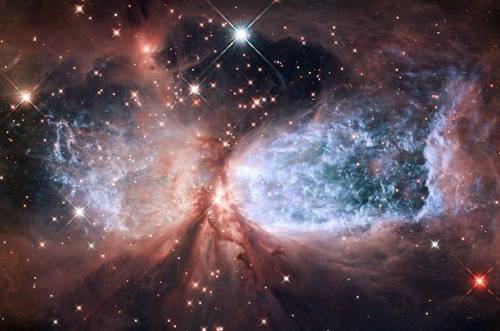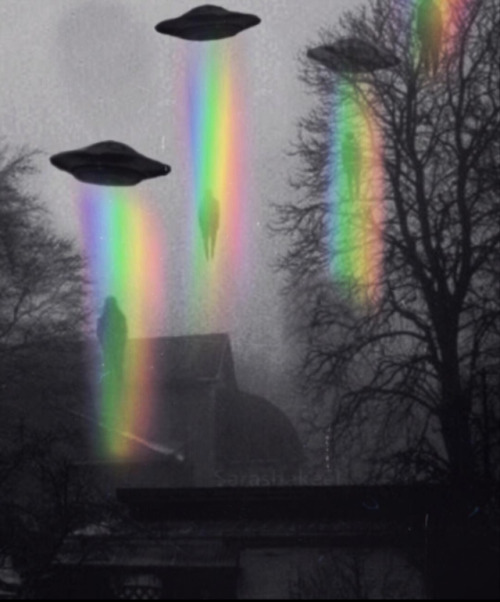Starsglaxiesspace - SPACE

More Posts from Starsglaxiesspace and Others

(NASA) Unexpected X-Rays from Perseus Galaxy Cluster
Image Credit: X-ray: NASA/CXO/Oxford University/J. Conlon et al.; Radio: NRAO/AUI/NSF/Univ. of Montreal/Gendron-Marsolais et al.; Optical: NASA/ESA/IoA/A. Fabian et al.; DSS
Why does the Perseus galaxy cluster shine so strangely in one specific color of X-rays? No one is sure, but a much-debated hypothesis holds that these X-rays are a clue to the long-sought identity of dark matter. At the center of this mystery is a 3.5 Kilo-electronvolt (KeV) X-ray color that appears to glow excessively only when regions well outside the cluster center are observed, whereas the area directly surrounding a likely central supermassive black hole is actually deficient in 3.5 KeV X-rays. One proposed resolution – quite controversial – is that something never seen before might be present: florescent dark matter (FDM). This form of particle dark matter might be able to absorb 3.5 KeV X-radiation. If operating, FDM, after absorption, might later emit these X-rays from all over the cluster, creating an emission line. However, when seen superposed in front of the central region surrounding the black hole, FDM’s absorption would be more prominent, creating an absorption line. Pictured, a composite image of the Perseus galaxy cluster shows visible and radio light in red, and X-ray light from the Earth-orbiting Chandra Observatory in blue.
Source

Rosetta: “Comet from 8km”
Description A section of the smaller of Comet 67P/Churyumov–Gerasimenko’s two lobes as seen through Rosetta’s narrow-angle camera from a distance of about 8 km to the surface on 14 October 2014. The resolution is 15 cm/pixel. The image is featured on the cover of 23 January 2015 issue of the journal Science. More information: Getting to know Rosetta’s comet
Credit: ESA/Rosetta/MPS for OSIRIS Team MPS/UPD/LAM/IAA/SSO/INTA/UPM/DASP/IDA





Alien megastructure not the cause of dimming of the ‘most mysterious star in the universe’
A team of more than 200 researchers, including Penn State Department of Astronomy and Astrophysics Assistant Professor Jason Wright and led by Louisiana State University’s Tabetha Boyajian, is one step closer to solving the mystery behind the “most mysterious star in the universe.”
KIC 8462852, or “Tabby’s Star,” nicknamed after Boyajian, is otherwise an ordinary star, about 50 percent bigger and 1,000 degrees hotter than the Sun, and about than 1,000 light years away. However, it has been inexplicably dimming and brightening sporadically like no other.
Several theories abound to explain the star’s unusual light patterns, including that an alien megastructure is orbiting the star.
The mystery of Tabby’s Star is so compelling that more than 1,700 people donated over $100,000 through a Kickstarter campaign in support of dedicated ground-based telescope time to observe and gather more data on the star through a network of telescopes around the world.
As a result, a body of data collected by Boyajian and colleagues in partnership with the Las Cumbres Observatory is now available in a new paper in The Astrophysical Journal Letters.
“We were hoping that once we finally caught a dip happening in real time we could see if the dips were the same depth at all wavelengths.
If they were nearly the same, this would suggest that the cause was something opaque, like an orbiting disk, planet, or star, or even large structures in space” said Wright, who is a co-author of the paper, titled “The First Post-Kepler Brightness Dips of KIC 8462852.” Instead, the team found that the star got much dimmer at some wavelengths than at others.
“Dust is most likely the reason why the star’s light appears to dim and brighten. The new data shows that different colors of light are being blocked at different intensities. Therefore, whatever is passing between us and the star is not opaque, as would be expected from a planet or alien megastructure,” Boyajian said.
The scientists closely observed the star through the Las Cumbres Observatory from March 2016 to December 2017. Beginning in May 2017 there were four distinct episodes when the star’s light dipped.
Supporters from the crowdfunding campaign nominated and voted to name these episodes. The first two dips were named Elsie and Celeste. The last two were named after ancient lost cities – Scotland’s Scara Brae and Cambodia’s Angkor. The authors write that in many ways what is happening with the star is like these lost cities.
The method in which this star is being studied – by gathering and analyzing a flood of data from a single target – signals a new era of astronomy. Citizen scientists sifting through massive amounts of data from the NASA Kepler mission were the ones to detect the star’s unusual behavior in the first place.
The main objective of the Kepler mission was to find planets, which it does by detecting the periodic dimming made from a planet moving in front of a star, and hence blocking out a tiny bit of starlight. The online citizen science group Planet Hunters was established so that volunteers could help to classify light curves from the Kepler mission and to search for such planets.
“If it wasn’t for people with an unbiased look on our universe, this unusual star would have been overlooked,” Boyajian said. “Again, without the public support for this dedicated observing run, we would not have this large amount of data.”
Now there are more answers to be found. “This latest research rules out alien megastructures, but it raises the plausibility of other phenomena being behind the dimming,” Wright said. “There are models involving circumstellar material – like exocomets, which were Boyajian’s team’s original hypothesis – which seem to be consistent with the data we have.”
Wright also points out that “some astronomers favor the idea that nothing is blocking the star – that it just gets dimmer on its own – and this also is consistent with this summer’s data.”
Boyajian said, “It’s exciting. I am so appreciative of all of the people who have contributed to this in the past year – the citizen scientists and professional astronomers. It’s quite humbling to have all of these people contributing in various ways to help figure it out.”



“Cosmic Neutrinos Can be Absorbed by Planet Earth”
Scientists using the IceCube Observatory located near the South Pole have discovered that neutrinos can be absorbed by our Planet Earth. With almost no mass and no charge, these particles rarely interact with matter. Yet tens of trillions of neutrinos pass through our bodies every second. Previous theories predicted that at high energies, neutrinos can be expected to interact with matter and be absorbed by the Earth instead of passing through the planet. “We knew that lower-energy neutrinos pass through just about anything, but although we had expected higher-energy neutrinos to be different, no previous experiments had been able to demonstrate convincingly that higher-energy neutrinos could be stopped by anything,” said Penn State Professor Doug Cowen. “However, the neutrino does have a tiny probability to interact, and this probability increases with energy. That probability is what scientists call the neutrino cross section.” The new measurements recorded by IceCube determined the neutrino cross section energies to be about 6.3 TeV and 980 TeV, energy levels significantly higher than previously measured.
Read more about this fascinating story at: http://www.newsoftheuniverse.com/2017/11/cosmic-neutrinos-can-be-absorbed-by.html



The end of time looks promising: by Sara Shakeel
-
 solarxlunar reblogged this · 5 years ago
solarxlunar reblogged this · 5 years ago -
 16fahri liked this · 6 years ago
16fahri liked this · 6 years ago -
 daemondamian liked this · 6 years ago
daemondamian liked this · 6 years ago -
 gecileves liked this · 6 years ago
gecileves liked this · 6 years ago -
 starkravingmeh liked this · 6 years ago
starkravingmeh liked this · 6 years ago -
 luluinlaalaaaland liked this · 6 years ago
luluinlaalaaaland liked this · 6 years ago -
 swagginismyhobby reblogged this · 6 years ago
swagginismyhobby reblogged this · 6 years ago -
 blacknprettyincloudcity liked this · 6 years ago
blacknprettyincloudcity liked this · 6 years ago -
 dani-glz-maltes liked this · 6 years ago
dani-glz-maltes liked this · 6 years ago -
 foxboidrew liked this · 6 years ago
foxboidrew liked this · 6 years ago -
 tyyiyi liked this · 6 years ago
tyyiyi liked this · 6 years ago -
 afterthedragonflies liked this · 6 years ago
afterthedragonflies liked this · 6 years ago -
 megalunalexi-aesthetic liked this · 6 years ago
megalunalexi-aesthetic liked this · 6 years ago -
 systemadministratorclu liked this · 6 years ago
systemadministratorclu liked this · 6 years ago -
 spookyking reblogged this · 6 years ago
spookyking reblogged this · 6 years ago -
 spookyking liked this · 6 years ago
spookyking liked this · 6 years ago -
 midwest-apples liked this · 6 years ago
midwest-apples liked this · 6 years ago -
 ytelovski liked this · 6 years ago
ytelovski liked this · 6 years ago -
 parts-of-me-unravelling liked this · 6 years ago
parts-of-me-unravelling liked this · 6 years ago -
 superearthquakefest liked this · 6 years ago
superearthquakefest liked this · 6 years ago -
 almostperfectwizard liked this · 6 years ago
almostperfectwizard liked this · 6 years ago -
 breanthir-laufeyson-the-jedi liked this · 6 years ago
breanthir-laufeyson-the-jedi liked this · 6 years ago -
 simsworldsurfer liked this · 6 years ago
simsworldsurfer liked this · 6 years ago -
 irate-pirate-bi-27 liked this · 6 years ago
irate-pirate-bi-27 liked this · 6 years ago -
 beachislove13 reblogged this · 6 years ago
beachislove13 reblogged this · 6 years ago -
 michael-rocket liked this · 6 years ago
michael-rocket liked this · 6 years ago -
 sharkspaceengine liked this · 6 years ago
sharkspaceengine liked this · 6 years ago -
 spiltcandycoatedpunkblood liked this · 6 years ago
spiltcandycoatedpunkblood liked this · 6 years ago -
 astrophe-elegy liked this · 6 years ago
astrophe-elegy liked this · 6 years ago -
 mutato-nomine-music liked this · 6 years ago
mutato-nomine-music liked this · 6 years ago -
 9allinballsdeep-blog reblogged this · 7 years ago
9allinballsdeep-blog reblogged this · 7 years ago -
 9allinballsdeep-blog liked this · 7 years ago
9allinballsdeep-blog liked this · 7 years ago -
 fillyreports liked this · 7 years ago
fillyreports liked this · 7 years ago -
 dwinkle liked this · 7 years ago
dwinkle liked this · 7 years ago -
 erisdemeter liked this · 7 years ago
erisdemeter liked this · 7 years ago -
 bigmama419-blog reblogged this · 7 years ago
bigmama419-blog reblogged this · 7 years ago